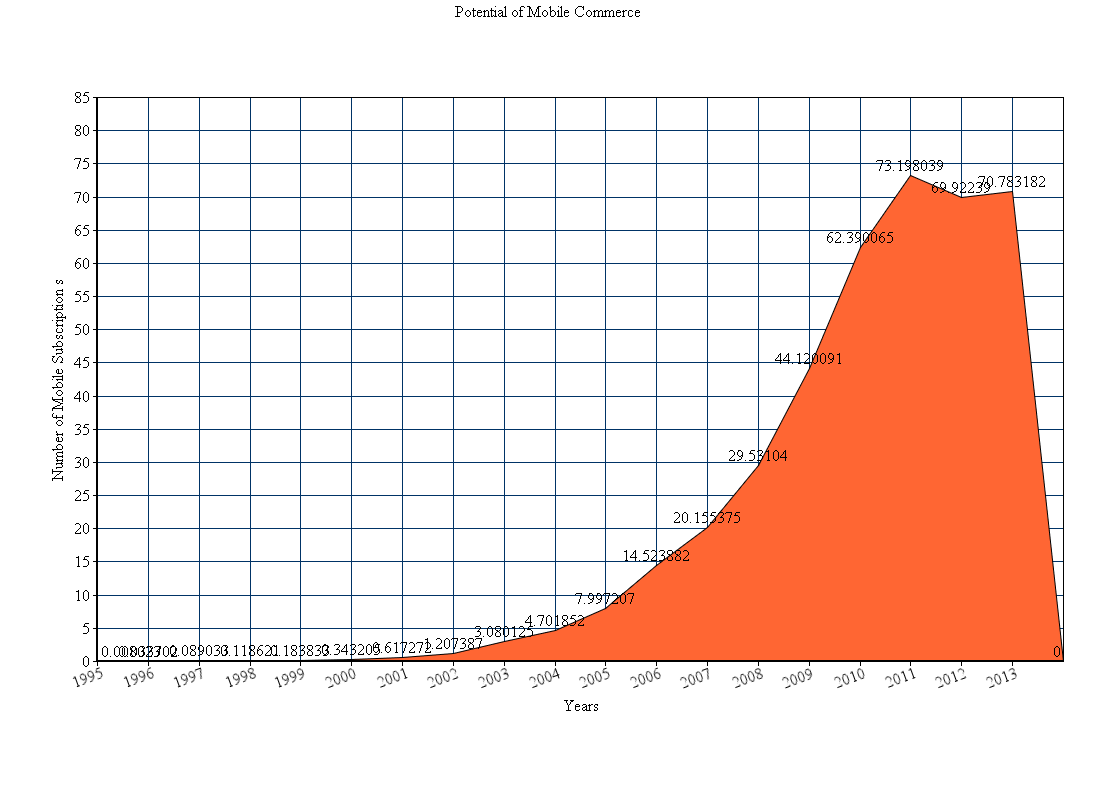What does mobile commerce require? Superficially, it requires an incidence of a significant number of mobile phones among the potential users of the service. The other major requirement is obviously the willingness to use the mobile phones for these purposes. With the advent of apps for various ecommerce stores, the latter has mostly been taken care of, but it is the former that needs special attention while analyzing the potential of m-commerce.
Mobile Commerce in India
Mobile commerce has its origin in the incidence of increasing reach of smart phones among the common Indian. The figure below shows the subscription of mobile phones in India since 1995.

Figure 1: Mobile Subscription in India per 100 people; Source: World Bank Database
The growth of mobile phone subscriptions has been at a CAGR of 24.6% since 1995. A high CAGR of 24.6% points out that the growth in number of mobile phones in India is imminent. However, the other question here is that how many of these phones are smart phones? The question is important because the idea of M-commerce relies quite heavily on smart phones and not the generic mobile phones with only basic functions.
If we look at the potential of smart phone markets in India, we would find that India has the fastest growth in this market in the last quarter of 2014 (Mahajan, 2014) with a registered growth of 27%. The penetration is currently only at 10%. About 900mn people are subscribed to mobile phones but of this only 110-120mn people have smart phones (Bajarin, 2014). Ericson’s report on growth of mobile broadband in India, however forecasted that by 2020, the expected smart phone penetration will be 45% for a base of 1145mn mobile phone subscribers (IndianExpress, 2014).
This clearly points out that the future of smart phone industry in India is all set to grow at a very appealing rate. So, the current time might be very ripe for the dawn of mobile commerce- a new marketing system in India. To prove/disprove this hypothesis, let us look at the potential of this new regime in the context of India.
The sector of mobile commerce in India is currently largely restricted to payment systems and is in very nascent stage. With the release of guidelines from the RBI about the usage of mobile for banking, banks like SBI have started rolling out apps like SBI-Freedom and State Bank Anywhere. The Indian ecommerce player Flipkart has made a mandatory download of its app for shopping through phones. This points to the fact that purchasing is now easy through mobile phones.
Another interesting development that has been in this regard is PayMate– the leading players in this sector. PayMate does not require the users to download their android app or be activated in GPRS which makes its service available to all phones.
The above discussion about mobile-based commerce in India points out the fact that the transition from laptops is imminent in the near future, particularly due to the favorable growth in the Indian Telecom Sector. Barring the psychological factors of mobile commerce, the increase in the smart phone penetration closely followed by the shift of laptop/desktop ecommerce to mobile ecommerce, posits a huge potential of a mobile-driven ecommerce in India. The sector is evolving and the time might be just right to enter the new domain of m-commerce in new and innovative ways.
Please feel free to contact us , if you have any query related to m-commerce.
References:
Bajarin, B. (2014, December 2). Why India Will Be the World’s Second Biggest Smartphone Market. Retrieved April 4, 2015, from www.time.com: http://time.com/3611863/india-smartphones/
IndianExpress. (2014, May 9). Smartphone penetration to reach 45% in india by 2020: Ericsson. Retrieved April 4, 2015, from www.indianexpress.com: http://indianexpress.com/article/technology/technology-others/ericsson-identifies-key-elements-of-mobile-broadband-growth-in-india/
Mahajan, A. C. (2014, December 3). Indian Smartphone Market Fastest Growing In Asia-Pac. Logs 27% Quarterly Growth. Retrieved April 4, 2015, from www.track.in: http://trak.in/tags/business/2014/12/03/indian-smartphone-market-share-growth/


